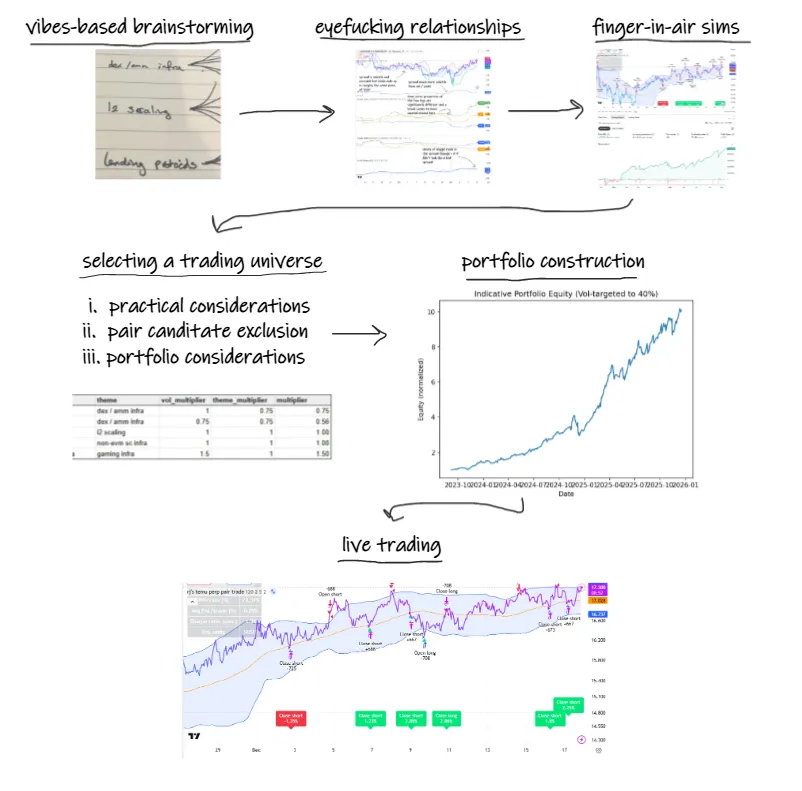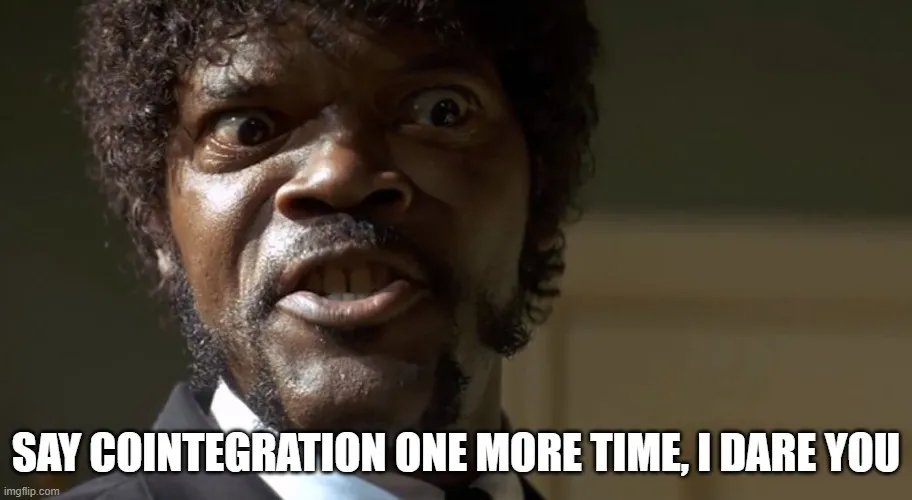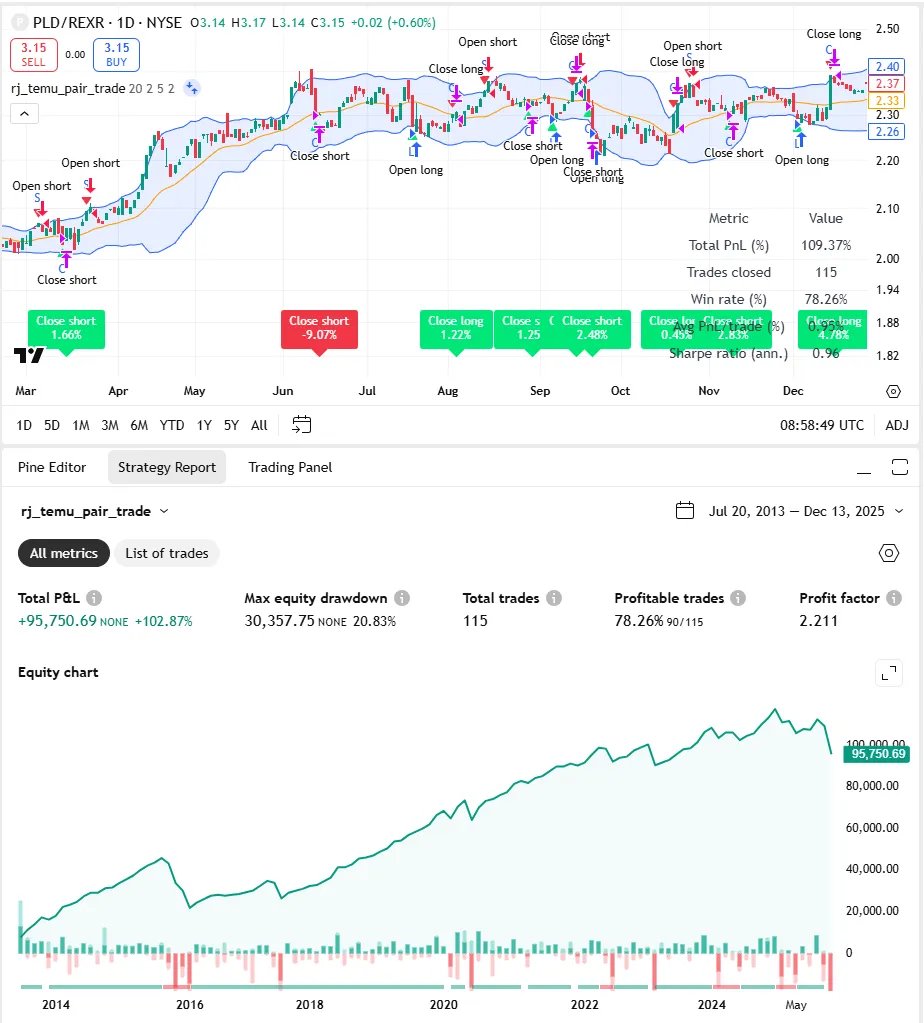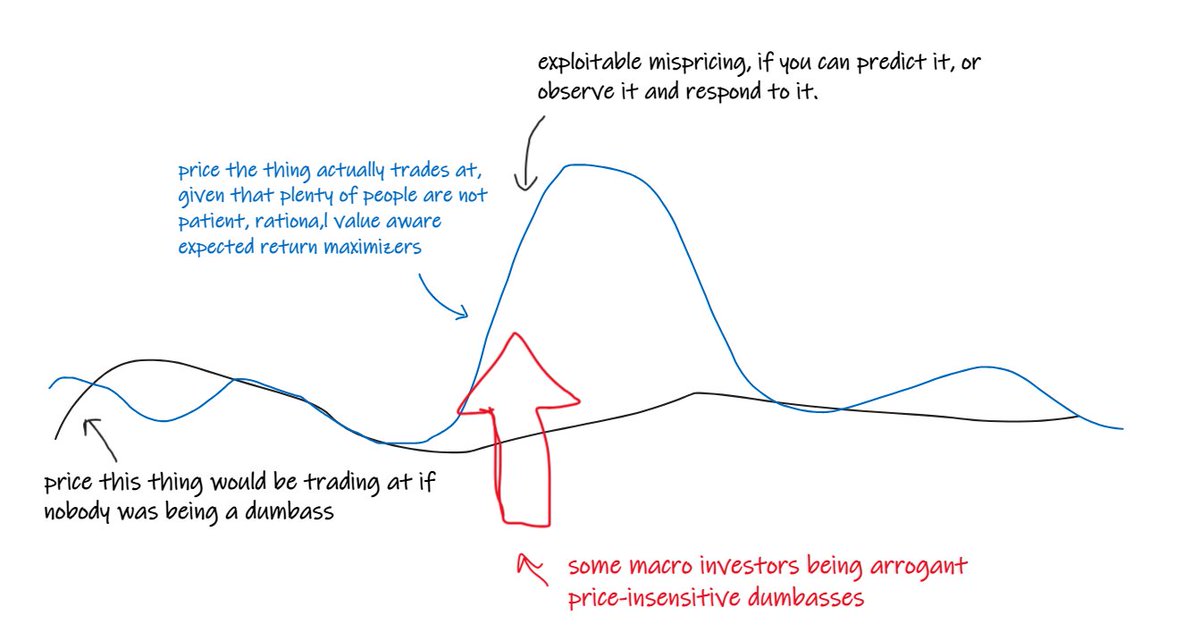Quick thread on "price" changes and market makers.
Consider a market that looks like this.
The best bid is 98
The best offer is 102
What's the price?
Depends who's asking.
Consider a market that looks like this.
The best bid is 98
The best offer is 102
What's the price?
Depends who's asking.

To keep it simple, assume we only ever want to trade 1 contract.
If we wanted to buy right now, we would need to pay $102.
Somebody is offering to sell at $102.
(Probably, but not necessarily, a market maker.)
We can buy from them at that price.
If we wanted to buy right now, we would need to pay $102.
Somebody is offering to sell at $102.
(Probably, but not necessarily, a market maker.)
We can buy from them at that price.

If we wanted to sell right now, we could do it at $98.
Somebody is bidding to buy at $98
We can sell to them at that price.
Somebody is bidding to buy at $98
We can sell to them at that price.

We have to pay up to buy at 102
We have to accept less to sell at 98.
We can't force other traders to want to trade with us.
If we want to get into a position with urgency and certainty, we will need to make it worth somebody's time.
You need to tip your friendly market maker
We have to accept less to sell at 98.
We can't force other traders to want to trade with us.
If we want to get into a position with urgency and certainty, we will need to make it worth somebody's time.
You need to tip your friendly market maker
Empathy is important in trading, as in life.
So, let's consider the world from the market maker's perspective.
Assuming she is unconstrained, she probably thinks the "fair value" of this instrument is 100.
What does that mean?
So, let's consider the world from the market maker's perspective.
Assuming she is unconstrained, she probably thinks the "fair value" of this instrument is 100.
What does that mean?

If she quotes evenly around her fair value, she expects as many people to buy from her at her offer, as will sell to her on her bid.
(In this case she is bidding to buy 2 ticks below "fair" and offering to sell 2 ticks above "fair")
(In this case she is bidding to buy 2 ticks below "fair" and offering to sell 2 ticks above "fair")

Her ideal situation is that the market's fair value of this instrument doesn't change at all.
She's just buying at $98, selling an equal amount at $102 all day.
Nothing exciting. No dramas.
She's just buying at $98, selling an equal amount at $102 all day.
Nothing exciting. No dramas.

Every time she trades, she accrues an unrealized profit of $2.
When someone sells to her at $98, she buys at $98.
And immediately she shows a $2 unrealised profit against the midpoint at $100.
When someone sells to her at $98, she buys at $98.
And immediately she shows a $2 unrealised profit against the midpoint at $100.

When somebody buys from her at $102, she sells at $102.
And immediately she shows a $2 unrealised profit against the midpoint at $100.
Seems like a sweet deal for the market maker, eh?
Yeah, in this case it does.
In others, not so much...
And immediately she shows a $2 unrealised profit against the midpoint at $100.
Seems like a sweet deal for the market maker, eh?
Yeah, in this case it does.
In others, not so much...
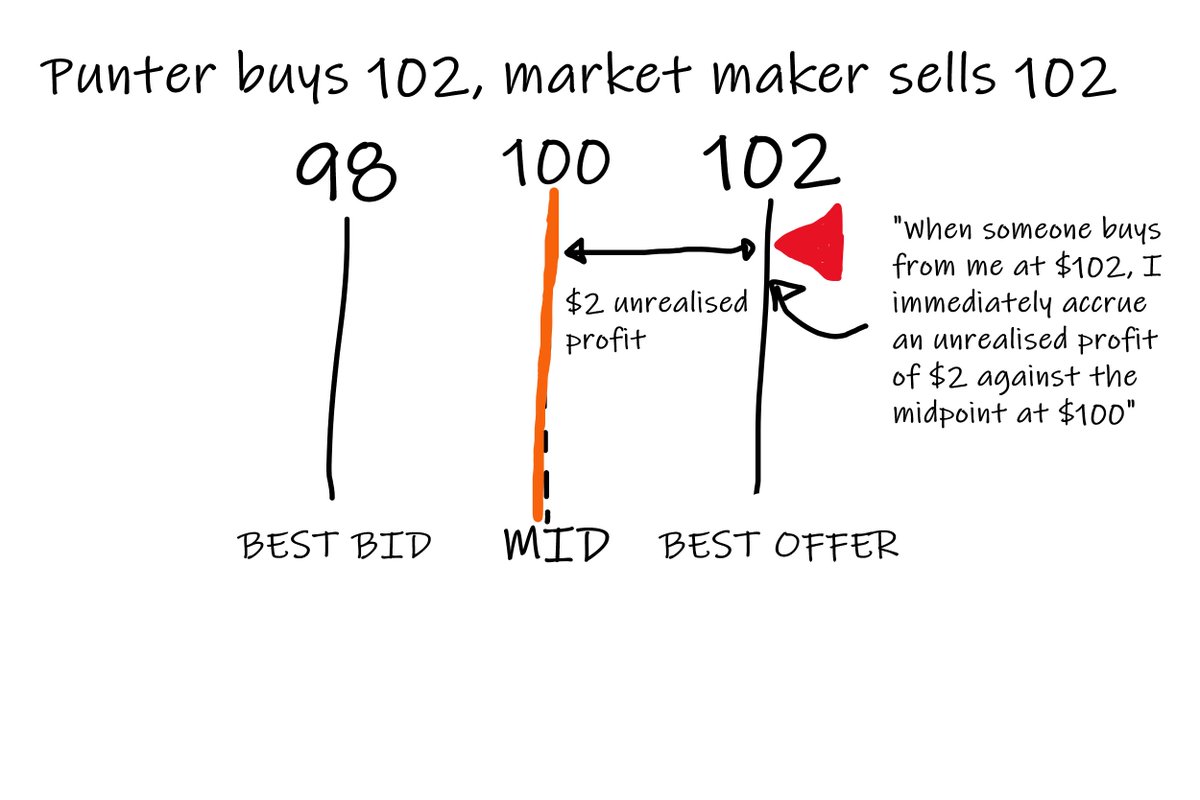
So far, we've assumed an omnipotent market maker who knows exactly the price to quote around to balance future supply and demand.
In reality, the market maker doesn't know where this point is - she can only estimate it.
In reality, the market maker doesn't know where this point is - she can only estimate it.

Also, shit happens.
Things happen that cause traders/investors to revise their opinions on asset values.
If every other tech stock is pumping on some news, punters are probably gonna be prepared to pay more for the one you're looking at (and sellers will demand more).
Things happen that cause traders/investors to revise their opinions on asset values.
If every other tech stock is pumping on some news, punters are probably gonna be prepared to pay more for the one you're looking at (and sellers will demand more).

So our market maker can find herself in a position where she's doing much more buying than selling, or vice versa.
This is either because:
- she forecasted "fair value" wrong
- unforecastable shit happened, and she couldn't react to it quick enough.
This is either because:
- she forecasted "fair value" wrong
- unforecastable shit happened, and she couldn't react to it quick enough.
In the case where she finds herself quoting too rich, people will be selling to her at an elevated price.
And fewer people paying up to buy from her.
So, she finds herself rapidly accumulating long inventory.
And paying too much for it.
And fewer people paying up to buy from her.
So, she finds herself rapidly accumulating long inventory.
And paying too much for it.

She might not have realized she was quoting too rich at the time, but she does now people are dumping on her.
So, her own accumulating inventory is her prompt to revise her view of "fair value" lower.
Now, it's clear she actually accrued a loss on those buys at the bid.
So, her own accumulating inventory is her prompt to revise her view of "fair value" lower.
Now, it's clear she actually accrued a loss on those buys at the bid.

So, life for market makers is not always super easy.
Her mission is to find the point that balances supply/demand over the next increment in time.
Then revise her quotes fast based on:
- her own trading telling her she's priced wrong.
- other stuff happening in the market
Her mission is to find the point that balances supply/demand over the next increment in time.
Then revise her quotes fast based on:
- her own trading telling her she's priced wrong.
- other stuff happening in the market
In the example we're working with, our friend would revise her quotes lower, to a point where buys and sells are more balanced.
Or, if not balanced, skewed in a way that she can reduce her accumulated inventory.
She thinks fair is 95.
But she now bids 92 and offers 96
Or, if not balanced, skewed in a way that she can reduce her accumulated inventory.
She thinks fair is 95.
But she now bids 92 and offers 96

She still has a 4 tick spread between bid and ask, but she has made her offer more attractive.
The offer is $1 away from where she thinks "fair" is.
The bid is $3 away.
She now expects more people buying from her, reducing her accumulated inventory.
The offer is $1 away from where she thinks "fair" is.
The bid is $3 away.
She now expects more people buying from her, reducing her accumulated inventory.

In this example, her own trading caused her to realize she was priced wrong.
It doesn't need to be this way.
She might have a better forecast or be able to react quick enough that she doesn't need to trade at bad prices to discover where supply and demand will be balanced.
It doesn't need to be this way.
She might have a better forecast or be able to react quick enough that she doesn't need to trade at bad prices to discover where supply and demand will be balanced.
She might be getting equal volumes of buying and selling quoting around $100.
But she notices a correlated instrument move big.
And she quickly revises her quotes lower, before others react and rush to sell to her.
But she notices a correlated instrument move big.
And she quickly revises her quotes lower, before others react and rush to sell to her.

We've now covered the main mechanisms by which price changes occur.
They occur because market makers are attempting to balance supply and demand, so they don't end up carrying a bunch of inventory long or short.
They occur because market makers are attempting to balance supply and demand, so they don't end up carrying a bunch of inventory long or short.
Quotes are revised:
- Reactively because market makers end up on the wrong side of moves and adapt their quotes
- Pro-actively because they can forecast or react fast to changes.
Now that's enough about market makers, let's go back to the original example and think about you.
- Reactively because market makers end up on the wrong side of moves and adapt their quotes
- Pro-actively because they can forecast or react fast to changes.
Now that's enough about market makers, let's go back to the original example and think about you.
The smartypants market maker, with all his almost-infinite resources, thinks the fair value of this instrument is $100.
Why would you buy it at $102, immediately showing a $2 unrealized loss at the midpoint?
Why would you buy it at $102, immediately showing a $2 unrealized loss at the midpoint?

Short answer: cos you think the fair value of thing (over your trade horizon) is more than $102.
If we thought that the instrument was going to be trading at $110 at the end of the day, we would be happy to pay $102 to get into the position with an expected return of $8.
If we thought that the instrument was going to be trading at $110 at the end of the day, we would be happy to pay $102 to get into the position with an expected return of $8.

"Ok ok" you say. "But why would I be right and the market maker be wrong?"
And one good answer, if you are an HFT firm, is that you can react to stuff before a market maker can amend their quotes.
But you are not an HFT firm.
And one good answer, if you are an HFT firm, is that you can react to stuff before a market maker can amend their quotes.
But you are not an HFT firm.
So other reasons are:
- you have modeled some effect that plays out over a longer timescale than fast traders care about.
- you have modeled some idiosyncratic effect that only happens occasionally that others have not modelled.
The first is most applicable to you, dear reader
- you have modeled some effect that plays out over a longer timescale than fast traders care about.
- you have modeled some idiosyncratic effect that only happens occasionally that others have not modelled.
The first is most applicable to you, dear reader
I'll wrap this up here for a bit, cos I ran out of threads in the threader thing....
I'll continue this later in the week to include a discussion about adverse selection and expectation in the case you choose to trade on limit orders, rather than taking liquidity. 🙏❤️
I'll continue this later in the week to include a discussion about adverse selection and expectation in the case you choose to trade on limit orders, rather than taking liquidity. 🙏❤️
• • •
Missing some Tweet in this thread? You can try to
force a refresh


